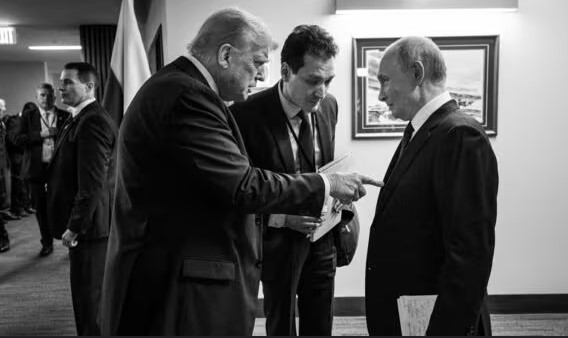The much-anticipated Alaska summit between US President Donald Trump and Russian President Vladimir Putin took place at Joint Base Elmendorf–Richardson in Anchorage, Alaska. High security, strict protocol, and ceremonial grandeur prepared the event, marking it as one of the most important diplomatic moments in recent times.
Red Carpet Welcome and High-Stakes Alaska Summit Setting
Trump landed in Anchorage aboard Air Force One, where officials decorated the tarmac with a red carpet and lined up four F-22 Raptor fighter jets to highlight American military strength. The Russian president arrived soon after and faced the same military display. Both leaders shook hands firmly on the red carpet and then walked together towards the Alaska summit venue.
Organizers staged the Alaska summit to reflect its importance on the global stage. With the Russia-Ukraine war still ongoing, observers regarded the meeting as one of the most critical interactions between Washington and Moscow in recent years. Hundreds of Trump supporters gathered nearby in Anchorage, waving American flags and holding banners in support of the president.
Trump draws red line — refuses to discuss Ukraine territory in Putin ceasefire talks
Inside the base, planners arranged the schedule so that neither leader appeared to wait for the other. Trump remained inside Air Force One until Putin arrived, and both leaders stepped into view in perfect coordination. Organizers set the stage for what many described as a “very high-stakes” Alaska summit.
Long Talks Focused on Ukraine Conflict
The Alaska summit between Trump and Putin lasted more than two and a half hours. Initially, it was a three-on-three discussion. Trump was accompanied by Secretary of State Marco Rubio and special envoy Steve Witkoff. Putin arrived with Russian Foreign Minister Sergey Lavrov and foreign policy adviser Yuri Ushakov. Later, Russia’s defence minister and senior American cabinet members joined the talks.
The White House reported that the war in Ukraine dominated the conversation. Trump stated during and after the talks that both sides discussed ways to reduce the large number of weekly casualties. He said, “We’re going to stop, 5,000, 6,000, 7,000 people a week from being killed, and President Putin wants to see that as much as I do.”
Reporters present in Alaska highlighted that the summit involved tough questions from the press. As Putin arrived, journalists shouted questions such as “When will you stop killing civilians?” The Russian president chose not to answer directly and gestured as if he could not hear.
US warns India of higher secondary tariffs if Trump-Putin talks fail in Alaska
At the press briefing after the Alaska summit, Trump described the talks as “extremely productive.” He said, “We had an extremely productive meeting, and we agreed on many points. There’s no deal until there’s a deal, but I believe we are very close.” Putin, on the other hand, referred to an “understanding” and urged Ukraine and European nations not to create obstacles to what he called “nascent progress.”
Despite the warm exchanges and ceremonial welcome, the leaders signed no formal agreement. Trump admitted that although they made progress, they still lacked a concrete deal. He repeated several times: “There’s no deal until there’s a deal.”
Trump’s Plan to Brief NATO and Zelenskyy After Alaska Summit
Following the Alaska summit, Trump confirmed that he would reach out to NATO leaders and Ukrainian President Volodymyr Zelenskyy to inform them of the discussions. He said, “I’ll call up President Zelenskyy and tell him about today’s meeting. It’s ultimately up to them.”
The US president added that NATO leaders would also be briefed soon. His comments suggested that the Alaska summit was meant to pave the way for further dialogue involving Ukraine and its allies. Trump rated the Alaska summit “ten out of ten” in terms of productivity, even though no final breakthrough was announced.
In his statements, Trump emphasized that while many points of agreement were reached, the responsibility to move the process forward now rested with Kyiv and European capitals. He stressed that Ukraine’s leadership, along with NATO, had to play an essential role in carrying the discussions ahead.
Trump announces summit with Putin and Zelensky, excluding NATO and EU
At one point during the media interaction, Trump hinted that he might even attend a possible meeting between Zelenskyy and Putin in the near future, though he did not specify details. Putin, speaking in rare English, added a curious note by suggesting, “Next time in Moscow.”
The Alaska summit concluded with both presidents leaving Anchorage within minutes of each other. While the talks did not deliver a formal resolution, they were marked by strong symbolism, red-carpet optics, and Trump’s assurance that NATO allies and Ukraine would be updated directly on what transpired in Alaska.

